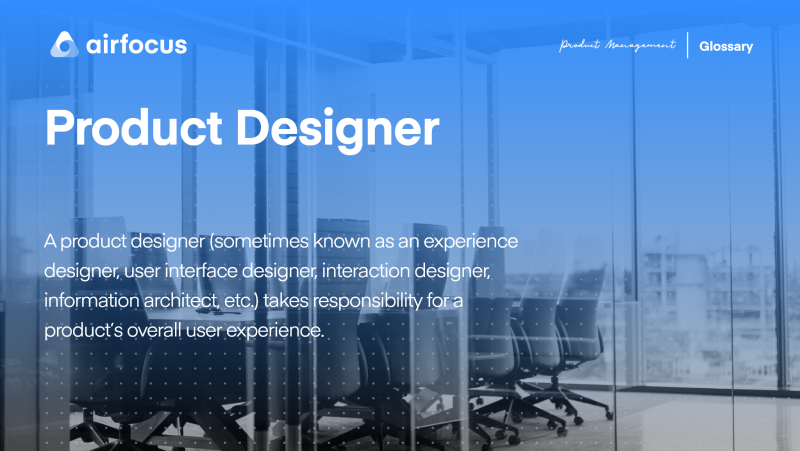Product Designer
What is a Product Designer
Definition of a Product Designer
A product designer (sometimes known as an experience designer, user interface designer, interaction designer, information architect, etc.) takes responsibility for a product’s overall user experience.
Working alongside the development team, a product designer/product architect acts as a champion of UX — as new features are built, or upgrades are rolled out, a product designer will always sense check how that would work in practice, and what impact it would have on the user experience.
What’s more, a product designer is responsible for the key elements that help make a product engaging for its target audience — its visual style, understanding of customer requirements/expectations, and more.
Whilst the exact role of a product designer will differ from business to business, their involvement could stretch from overseeing a product’s initial design, through to proof-of-concept and first iteration, all the way to product launch.
A product designer may take a direct role in the management of a product, or cultivate a close working relationship with a product manager or owner.
What does a product designer do?
Many product designers tend to play a core part in the initial steps of developing a product, right from the creation of the first concepts. They will be able to identify and determine the specific aims of a product, before transforming it into a practical tool which users can interact with.
After all, successful products cater to the users’ requirements, and the product designer’s work is crucial to this.
A product designer will offer feedback to the development team and provide guidance to help them identify which features should be prioritized to maximize a product’s value. To do so, product designers typically utilize a number of artifacts in their work, including wireframes, user journey maps, prototypes, and high-fidelity mock-ups.
Wireframes are essentially a very simplified, low-tech way to mock up product designs. Designers can create wireframes with just a pen and paper, but they may use software too.
The product designer can get their ideas down, reproduce them, and distribute them to others involved in the process.
Any concepts drafted in the wireframe can be eliminated and reworked with minimal waste of time or resources.
User journey maps break down the flow of a user’s experience with a product, charting their movements through a specific process or task step by step.
They show the different actions and triggers the user encounters.
Drawing user journey maps allows the product designer to understand potential obstacles affecting the user’s experience and implement changes to solve the problem. This process can benefit from gauging feedback from other key members of the product team and even potential customers, via early user testing.
User testing is usually a key responsibility for a product designer. To ensure that this research provides realistic and valuable insight into user experience, product prototypes may be used in place of a finished launch-ready product.
A prototype could be rendered in a number of potential forms, such as on paper or in a digital version. Either way, prototypes allow the product designer to explore the user experience at different stages of development. As such, prototypes can identify potential issues and lead to the highest standard of functionality at launch.
Finally, high-fidelity mock-ups reflect an almost-complete version of the product to capture a practical sense of the final package. They act as a blueprint to guide the development team and incorporate the aesthetic touches (color, fonts, etc.) agreed upon.
A satisfying user experience can be compromised by minor mistakes and oversights. Other functional issues, such as slow page loading or weak navigation, may reduce useability too. It’s up to the product designer to ensure these are caught before a product reaches the market.
What skills should a product designer have?
The best product designers have a comprehensive knowledge and awareness of the different elements involved in translating a concept into a final market-ready item. They may be capable of coding, taking a hands-on role in creating design elements (interface icons, for example), and more.
The more a product designer can bring to the table, the better. Deep knowledge of product development, design, and customer insight will ensure the final product meets (or even exceeds) user expectations and needs.
As you’d expect, product designers must have a creative streak and an ability to understand what users are looking for in specific areas. For example, they might need to recognize opportunities to innovate and bring something fresh to the market. A background in research and design can prove beneficial in this respect.
Another key part of being an effective product designer is being experienced with common design tools, including Photoshop. Not only does this empower them with a working knowledge of the platforms used by the development team, but it means they can take a more direct role too.
Product designers should also possess enough strength of character and confidence to indicate when a product is straying from the right path. This might involve directing the development team to remove a feature that disrupts user experience or suggesting a more appropriate course of action.
Essentially, a product designer must keep the user’s satisfaction and needs in their sight at all times — not allowing their own bias, ego, or the pressures from the wider team to take over.
Being able to interact with users, follow market trends, analyze user feedback, and conduct research into similar products is a major advantage too. A good product designer brings all of this to the role and helps companies launch the best products they’re capable of.

General FAQ

Glossary categories
Experience the new way of doing product management

Experience the new way of doing product management








